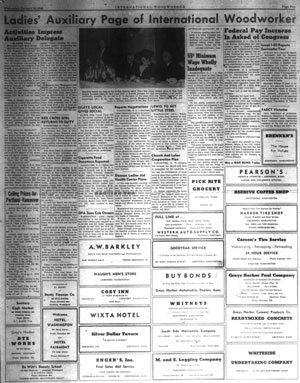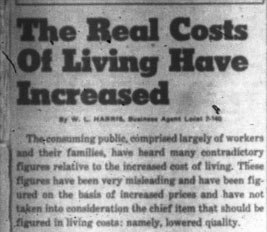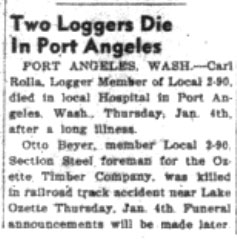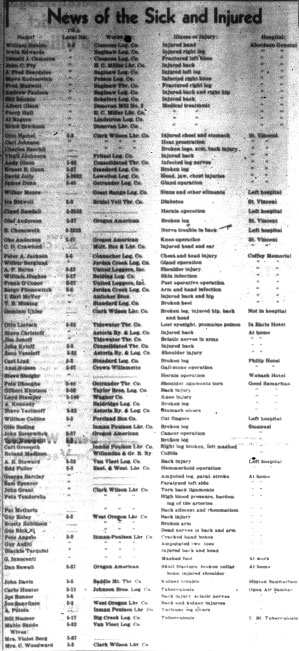International Woodworker
|
Report by Bryan Schnase Abstract: The International Woodworker succeeded The Timber Worker as the official publication of International Woodworkers of America. The paper lasted for 45 years, providing union news, current events, editorials, safety reports, and accident reports (a major issue in the logging and timber industry). It started as a weekly periodical, then went to bi-monthly by the 1960s, and ended being a once-a-month publication by the end of the 1970’s. Union Affiliation: International Woodworkers of America, CIO (1942-1955), AFL- CIO (1955-1987) Location: Seattle, Washington (1942-1943), Portland, Oregon (1943-1987) Dates Published: January 21, 1942 – April 28, 1987Size: 8-15 pages, with an average of 12. Circulation area: Greater Pacific Northwest area including Washington, Oregon, Idaho, and British Columbia, Canada. Editors: Manley J. Wilson, Phil Frost, Richard Spohn Collection: University of Washington, Suzzallo Library A3977 Status: Incomplete. Earlier films quality not as good as later ones but all are readable. The International Woodworker evolved out of The Timber Worker in January 1942 as a union paper for the local timber and logging industries of the Pacific Northwest. During the 1940’s the paper was affiliated with the CIO, and later the AFL-CIO. Typically consisting of 12-15 pages and published weekly, bi-weekly, and monthly, the newspaper was sent to members of the IWA. It included news of other woodworker unions around the country, along with national news stories that were relevant to working class union members. This usually took up the first and second pages of the paper. The bulk of the next four or five pages dealt with stories pertaining to local issues. Here you find stories of what is going on at the local chapters of the IWA or other local unions whose industry has some bearing on the timber industry. The rest of the paper was used for advertisements, regular columns, a women’s auxiliary page, cartoons, comics, and safety and healthcare issues. Union News The Woodworker was a main source of labor news for union members. It covered everything from international stories to small, local activities. Internationally and nationally it focused on union issues and politics having direct bearing on labor and the union. Stories came from as far away as Ottawa and Toronto, from Tennessee and Oklahoma or other parts of the U.S. and Canada where the union was part of the timber industry. Being a CIO affiliated paper you might expect to find articles that showed the struggles between the AFL and CIO and their differing ideologies, but for the most part articles written about the AFL were sympathetic and reflected the hope that the union federations would work together. However, there were on occasion articles hinting at the tensions between the two. A 1945 article discusses the contest between IWA and the rival AFL woodworkers union for representation of workers at the Booth-Kelly Lumber Company, where the AFL had forced a decertification election. The IWA wins the election and the International Woodworker criticizes the AFL for "disruptive labor-splitting tactics" but otherwise doesn’t show the bitterness of the battles between the AFL and CIO in the past. (4/18/45) Articles showing the AFL and CIO coming together and unifying for organized labor were more common, especially in the 1950s as the two federations moved toward reunification. In elections celebrating CIO-endorsed candidates, the praise went for all the candidates who supported labor, whether their background was with the CIO or the AFL.(5/28/53) Another example is seen in an Idaho court ruling. The article states "the decision upholds the contention of AFL and CIO leaders in the state who took the case before the court."(8/25/54) Although the Woodworker was a CIO affiliated newspaper, by the end of the forties and into the early fifties their focus wasn’t on showing the rift between the two labor union federations. Keeping Wages Fair The Woodworker also ran numerous stories having to do with wages, minimum wage, and back-pay settlements due to union members from employers. Minimum wage laws get a lot of coverage, both locally and nationally. In a 1945 issue the paper ran a story of a minimum wage increase at a veneer plant in Portsmouth, Virginia. It details an agreement between the IWA Local 389 and the Dixie Veneer Company, which established a minimum wage of fifty cents an hour.(2/14/45) The increase brought the pay of women working at the plant from 40 cents/hr. to 50 cents/hr. This and other stories like it are evidence of the fight by labor to get the working class a fair cut of the profits, reward the women for keeping production up while many men went off to war, and to get employers making huge profits from the war to spread the wealth to the workers. Locally, the paper was also interested in fighting for better wages. In Oregon in 1961 the paper reports on an amendment to a bill that would take away an exemption which left logging crews of 12 or fewer exempted from the minimum wage laws. The paper reports that this practice allowed owners to contract out for help to cut company owned timber, keeping work size down and allowing the owners to set the wage scale below the minimum wage level.(2/22/61) Another issue the Woodworker focused on was back pay due to union members. A 1946 front page had a story from Memphis, Tenn. in which the IWA-CIO won $60,000 in back wages to be paid to employees. On the same page was a local story of retroactive pay for workers at the Buol Logging Co., who received 71/2 cents an hour going back 3 months.(1/10/46) This trend of front-page coverage indicates that the paper is making sure that union members know about the victories, both local and national. The idea of working shorter hours was also a common theme in the paper. In the same way the union kept members unified and informed with stories of settlements and back-pay awards, they ran quite a few stories promoting the idea of shorter working days. A 1953 article calling for the 6-hour workday, draws parallels back to early strikes of the shingle weavers and Wobblies demanding an 8-hour day.(2/11/53) Twenty-five years later, in 1977, the IWA’s position still held its course. There were stories quoting recent studies showing the decrease in working hours over time for the last century in America. The paper said that the 40-hour workweek could soon be down to a 35-hour workweek.(10/19/77) Support for the War During World War II the paper dealt with the strain it put on the working class while presenting a positive, patriotic attitude. Whether it was stories run on the front page giving praise and recognition to local chapters supporting the "Buy a Bomber" campaign(1/28/42), or running half page recruitment ads on why experienced seamen should re-enlist and help "finish the job"(1/3/45), the union’s support for the war effort was fairly obvious. In light of losing manpower out of the working class to go overseas and fight, the IWA worked to keep union members unified and focused to meet the high production demands put on industry nationwide. The editorial page provided "pep talks" on the importance of keeping production up and remembering that American lives still depended on the output of American industry. The paper also ran stories praising record production levels, trying to keep members morale up in times of rationing and a wavering economy. Although the IWA showed strong support for the war, they didn’t always agree with government proposals or decisions that directly affected the union and its members. A major issue of contention between labor and the government was over plans to draft manpower. In a 1945 front page, the union boldly opposed FDR’s plan for national service legislation, with its work-or-fight conscription. The union viewed these stipulations as providing union busting possibilities.(1/24/45) Taft-Hartley Hatred There was no doubt about the IWA’s position on the Taft-Hartley Act of 1947. News about the new law made the front page, along with editorial cartoons showing the "execution" of labor. The union believed that this Act would increase labor disputes rather than settle them, that the government would have too much say in matters of collective bargaining, and that the purpose of the Act was to make strikes more difficult rather than more unnecessary. This opposition to what the union saw as the government aiding big business lead the union to urge members to vote, while educating them of the shift of power away from the President and into the Congress. Truman’s presidency after 1948 was the example the union used to show that Congress wielded more power than the President. The newspaper often featured articles explaining that voting mattered and was the key to stopping further anti-labor legislation.(5/28/52) Focus on Safety Throughout the history of the Woodworker, the most common issue addressed is that of safety and creating a safer work environment in the most "dangerous industry in the nation."(9/10/52) Attempts to make members more safety conscious came in numerous forms. An illustrated scene of a logging accident, diagramed and detailed with descriptions of what went wrong and why, was always presented under the heading of "A Woodworker Died Here".(11/26/52) Small articles providing statistics on accident rates and such things as the cost of workmen’s compensation benefits for the year were even more common.(1/26/72) Once in a while a page was dedicated to a special feature on safety. It would briefly outline the importance of safety and awareness, along with clearly showing the importance of the timber industry and its effects in everyday life. Photos of different logging or sawmill scenes would be followed by safety tips and learning how to prevent accidents.(1/10/45) Almost weekly a section was dedicated to "News of the Sick and Injured", in which were listed names of the newly injured along with identifying information including their employer, their union local and the hospital where they were treated.(1/3/45) Along with the weekly or monthly features, regular news articles on safety were in virtually every issue. These stories highlighted safety programs and attempts for better government regulations promoting safety in the workplace. In 1970 organized labor helped pass the Occupational Safety and Health Act, OSHA. The IWA viewed this as a very important issue for the union due to the hazards of the industry, and urged workers to "remain active in searching out hazards to members on the job and demand immediate correction. The lives and well-being of the individual member and his family require the assurance of safe and healthful employment."(1/12/72) Other stories cited the poor performance by Washington State’s logging and enforcement programs on evaluations by OHSA in light of increased numbers of fatalities over previous years.(10/19/77) The IWA ran stories to keep worker awareness on the importance of safety, and to show members the importance of allowing regulations like OSHA to work for the employee and not let the employer cut corners, especially when it comes to worker’s safety. Advertisements, Ladies Auxiliary, and "About Open Spaces evolved out of The Timber Worker in January 1942 as a union paper for the local timber and logging industries of the Pacific Northwest. During the 1940’s the paper was affiliated with the CIO, and later the AFL-CIO. Typically consisting of 12-15 pages and published weekly, bi-weekly, and monthly, the newspaper was sent to members of the IWA. It included news of other woodworker unions around the country, along with national news stories that were relevant to working class union members. This usually took up the first and second pages of the paper. The bulk of the next four or five pages dealt with stories pertaining to local issues. Here you find stories of what is going on at the local chapters of the IWA or other local unions whose industry has some bearing on the timber industry. The rest of the paper was used for advertisements, regular columns, a women’s auxiliary page, cartoons, comics, and safety and healthcare issues. Union News The Woodworker was a main source of labor news for union members. It covered everything from international stories to small, local activities. Internationally and nationally it focused on union issues and politics having direct bearing on labor and the union. Stories came from as far away as Ottawa and Toronto, from Tennessee and Oklahoma or other parts of the U.S. and Canada where the union was part of the timber industry. Being a CIO affiliated paper you might expect to find articles that showed the struggles between the AFL and CIO and their differing ideologies, but for the most part articles written about the AFL were sympathetic and reflected the hope that the union federations would work together. However, there were on occasion articles hinting at the tensions between the two. A 1945 article discusses the contest between IWA and the rival AFL woodworkers union for representation of workers at the Booth-Kelly Lumber Company, where the AFL had forced a decertification election. The IWA wins the election and the International Woodworker criticizes the AFL for "disruptive labor-splitting tactics" but otherwise doesn’t show the bitterness of the battles between the AFL and CIO in the past. (4/18/45) Articles showing the AFL and CIO coming together and unifying for organized labor were more common, especially in the 1950s as the two federations moved toward reunification. In elections celebrating CIO-endorsed candidates, the praise went for all the candidates who supported labor, whether their background was with the CIO or the AFL.(5/28/53) Another example is seen in an Idaho court ruling. The article states "the decision upholds the contention of AFL and CIO leaders in the state who took the case before the court."(8/25/54) Although the Woodworker was a CIO affiliated newspaper, by the end of the forties and into the early fifties their focus wasn’t on showing the rift between the two labor union federations. Keeping Wages Fair The Woodworker also ran numerous stories having to do with wages, minimum wage, and back-pay settlements due to union members from employers. Minimum wage laws get a lot of coverage, both locally and nationally. In a 1945 issue the paper ran a story of a minimum wage increase at a veneer plant in Portsmouth, Virginia. It details an agreement between the IWA Local 389 and the Dixie Veneer Company, which established a minimum wage of fifty cents an hour.(2/14/45) The increase brought the pay of women working at the plant from 40 cents/hr. to 50 cents/hr. This and other stories like it are evidence of the fight by labor to get the working class a fair cut of the profits, reward the women for keeping production up while many men went off to war, and to get employers making huge profits from the war to spread the wealth to the workers. Locally, the paper was also interested in fighting for better wages. In Oregon in 1961 the paper reports on an amendment to a bill that would take away an exemption which left logging crews of 12 or fewer exempted from the minimum wage laws. The paper reports that this practice allowed owners to contract out for help to cut company owned timber, keeping work size down and allowing the owners to set the wage scale below the minimum wage level.(2/22/61) Another issue the Woodworker focused on was back pay due to union members. A 1946 front page had a story from Memphis, Tenn. in which the IWA-CIO won $60,000 in back wages to be paid to employees. On the same page was a local story of retroactive pay for workers at the Buol Logging Co., who received 71/2 cents an hour going back 3 months.(1/10/46) This trend of front-page coverage indicates that the paper is making sure that union members know about the victories, both local and national. The idea of working shorter hours was also a common theme in the paper. In the same way the union kept members unified and informed with stories of settlements and back-pay awards, they ran quite a few stories promoting the idea of shorter working days. A 1953 article calling for the 6-hour workday, draws parallels back to early strikes of the shingle weavers and Wobblies demanding an 8-hour day.(2/11/53) Twenty-five years later, in 1977, the IWA’s position still held its course. There were stories quoting recent studies showing the decrease in working hours over time for the last century in America. The paper said that the 40-hour workweek could soon be down to a 35-hour workweek.(10/19/77) Support for the War During World War II the paper dealt with the strain it put on the working class while presenting a positive, patriotic attitude. Whether it was stories run on the front page giving praise and recognition to local chapters supporting the "Buy a Bomber" campaign(1/28/42), or running half page recruitment ads on why experienced seamen should re-enlist and help "finish the job"(1/3/45), the union’s support for the war effort was fairly obvious. In light of losing manpower out of the working class to go overseas and fight, the IWA worked to keep union members unified and focused to meet the high production demands put on industry nationwide. The editorial page provided "pep talks" on the importance of keeping production up and remembering that American lives still depended on the output of American industry. The paper also ran stories praising record production levels, trying to keep members morale up in times of rationing and a wavering economy. Although the IWA showed strong support for the war, they didn’t always agree with government proposals or decisions that directly affected the union and its members. A major issue of contention between labor and the government was over plans to draft manpower. In a 1945 front page, the union boldly opposed FDR’s plan for national service legislation, with its work-or-fight conscription. The union viewed these stipulations as providing union busting possibilities.(1/24/45) Taft-Hartley Hatred There was no doubt about the IWA’s position on the Taft-Hartley Act of 1947. News about the new law made the front page, along with editorial cartoons showing the "execution" of labor. The union believed that this Act would increase labor disputes rather than settle them, that the government would have too much say in matters of collective bargaining, and that the purpose of the Act was to make strikes more difficult rather than more unnecessary. This opposition to what the union saw as the government aiding big business lead the union to urge members to vote, while educating them of the shift of power away from the President and into the Congress. Truman’s presidency after 1948 was the example the union used to show that Congress wielded more power than the President. The newspaper often featured articles explaining that voting mattered and was the key to stopping further anti-labor legislation.(5/28/52) Focus on Safety Throughout the history of the Woodworker, the most common issue addressed is that of safety and creating a safer work environment in the most "dangerous industry in the nation."(9/10/52) Attempts to make members more safety conscious came in numerous forms. An illustrated scene of a logging accident, diagramed and detailed with descriptions of what went wrong and why, was always presented under the heading of "A Woodworker Died Here".(11/26/52) Small articles providing statistics on accident rates and such things as the cost of workmen’s compensation benefits for the year were even more common.(1/26/72) Once in a while a page was dedicated to a special feature on safety. It would briefly outline the importance of safety and awareness, along with clearly showing the importance of the timber industry and its effects in everyday life. Photos of different logging or sawmill scenes would be followed by safety tips and learning how to prevent accidents.(1/10/45) Almost weekly a section was dedicated to "News of the Sick and Injured", in which were listed names of the newly injured along with identifying information including their employer, their union local and the hospital where they were treated.(1/3/45) Along with the weekly or monthly features, regular news articles on safety were in virtually every issue. These stories highlighted safety programs and attempts for better government regulations promoting safety in the workplace. In 1970 organized labor helped pass the Occupational Safety and Health Act, OSHA. The IWA viewed this as a very important issue for the union due to the hazards of the industry, and urged workers to "remain active in searching out hazards to members on the job and demand immediate correction. The lives and well-being of the individual member and his family require the assurance of safe and healthful employment."(1/12/72) Other stories cited the poor performance by Washington State’s logging and enforcement programs on evaluations by OHSA in light of increased numbers of fatalities over previous years.(10/19/77) The IWA ran stories to keep worker awareness on the importance of safety, and to show members the importance of allowing regulations like OSHA to work for the employee and not let the employer cut corners, especially when it comes to worker’s safety. Advertisements, Ladies Auxiliary, and "About Open Spaces" The back pages of the Woodworker were filled with plenty of advertisements, a ladies auxiliary page, and other weekly features like Fred Goetz’s column "About Open Spaces", Kip Knothaid’s "Dry Rot", and "Chip’s and Shavings" by George!. There were plenty of advertisements filling in spaces throughout the paper, especially towards the back. Some 1945 ads proudly stated, "100% Union Store", "Union Made", "Always ready to serve IWA-CIO members", or other slogans showing support for the union. (10/31/45) The majority of the ads had no such slogan or indication of being "for" unions. Most appear to be small, family owned private businesses. These small business owners understood their reliance on the timber industry and its impact on the local economies. Whether they supported the idea of unions or not, the small business owners more than likely supported the unions for economic factors if nothing else. The ads came from all over the Pacific Northwest. They ranged from British Columbia, throughout Washington, and much of Oregon. Most were from small, rural communities with strong ties to the timber industry. Mixed in with the ads it wasn’t uncommon to see banners saying "Buy Bonds" and notices to "Send in your reports of sick and injured members". Evidence of union views both on safety and the war were easy to find scattered throughout the paper. Women were also given a voice in the union by way of a woman’s auxiliary page. This page gave a voice to the women and wives of the union. In 1945 there were news stories about women workers and how labor was working for them throughout the country. (1/3/45) Other stories were inclined more towards issues in the average woman’s everyday life. These included articles explaining the food rationing during the war, the need for action over the rising cost and decline in quality of clothes, especially for children,(1/17/45) and ceiling prices on groceries in the local communities.(1/10/45) There were also a couple of regular features in the paper. "Dry Rot" by Kip Knothaid and "Chips and Shavings" by George! ran during the late 40’s and throughout the 50’s. Both were editorial columns often using current events stories to get a point across about the need to support or strengthen the union. Both of these columns seem to have a looser, more radical feel to them, like they’re rebelling a little against the norm to gain the interest of union members. In the 1970s a regular feature was Fred Goetz’s "About Open Spaces". This section was a chance for members to send in pictures of their fishing and hunting trophies, as well as tell stories and tidbits of their adventures. Along with submitted works, Mr. Goetz ads his own touches to the column, often stories about fishing during the different seasons or just plain factual information on the local region and its wildlife.(1/26/72) Summary For the most part The International Woodworker appears to be similar to other mainstream local papers. The main difference is that while other papers report on everyday news stories, the Woodworker is focused on issues directly related to the IWA or to organized labor. There is no real animosity or radical ideas being spread by the paper. Its goal or purpose seems to be to provide a means of keeping members current on labor and union issues, while educating them on important issues such as safety in the workplace. Although the paper may have had a more alternative or radical start as the Timber Worker in the mid 30’s, by the time of its evolution into the Woodworker during the early 40’s it seems to have settled into its role as an informative source of news for members of the IWA. |
Click to enlarge
Protecting Labor's Interests Not surprisingly, a majority of the paper was dedicated to reporting on strikes and arguing that wages in the timber industries needed to be increased.
World War II By the mid-1940s, the IWA and the International Woodworker had come to fully support America's war effort. Timber products were critical elements in the ships and planes that were being used to fight Fascism and Nazism overseas, and IWA came to believe that their work in the woods of the northwest was of crucial importance. Nevertheless, the union remained weary that some in governemnt and business might use the war as an excuse to attack the union and its economic gains.
CIO News In every edition, the International Woodworker ran a national CIO page, which kept members abreast of the decisions and opinions of national labor leaders.
Taft-Hartley When the Taft-Hartley act was passed in 1947, the IWA was horrified. Members feared that the act would roll back gains the union had made in the war era.
The Women's Auxiliary Boasting the largest women's auxiliary in the CIO, the IWA took great pride in its women's organizations and the paper frequently ran pages dedicated to women's news. More than mere social appendages, the women's auxiliaries of the IWA organized political action committees, assisted in strikes and on picket lines, and made great strides in furthering the IWA's programs.
Expanding Labor's Interests Like many CIO unions, the IWA's interest in economic equality expanded beyond the shop floor. The union supported efforts to expand the scope of affordable housing, childhood education, and minimum wage standards.
Safety in the Woods and Mills Safety was one of the IWAs principal interests. Working in mills, with large saws and machinery, or in lumber camps with logs falling everywhere was extremely dangerous, and every year, hundreds of IWA members were killed and thousands injured. Accordingly, the International Woodworker focused on safety issues and argued for stringent safety policies.
|
|
Copyright (c) 2001 by Bryan Schnase |
|

--Sept.%202,%201942--p.1.300w.jpg)
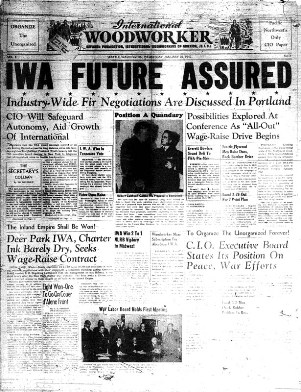
--Feb.%2025,%201942--p.1.300w.jpg)
--April%2025,%201945--p.1.300w.jpg)
--March%2018,%201942--p.1.300w.jpg)
--July%207,%201943--p.1.300w.jpg)
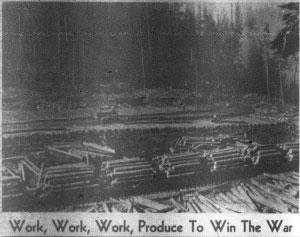

--Oct.%2028,%201942--p.6.300w.jpg)
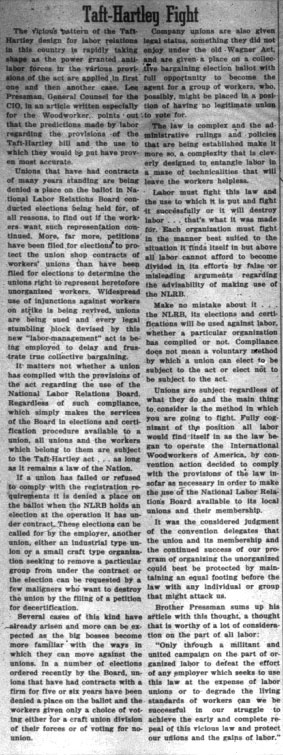
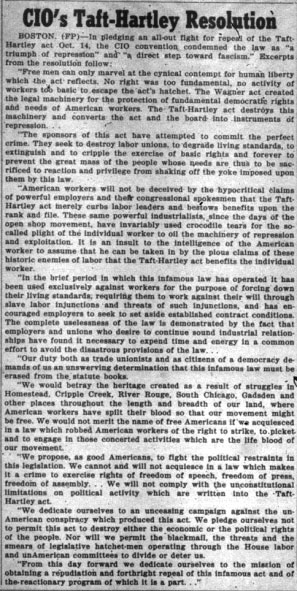

--Nov.%2018,%201942--p.5.300w.jpg)
